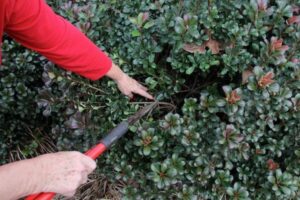In the (Freezing) Garden: Winter Pruning Shrubs and Bushes

Winter is the perfect time of year to begin pruning the shrubs and berry bushes in your yard or garden. Since the plants are mostly dormant or slowly coming back to life with new buds, it is ideal to cut off any unwanted or excess growth before the plant comes into full bloom. Pruning off dead or affected limbs can help keep away diseases and pests, and shaping your shrubs and bushes will help provide more blooms and fruit for the coming seasons. Learn the basics of winter pruning for shrubs and bushes in our short guide, and get back in the garden!
Timing
Pruning is best done when plants are dormant, but not in climates where hard frosts endure all winter, as cutting them when its very cold can send them into shock. It’s safe to start pruning once the risk of hard overnight frosts (below 20 degrees F) has passed, and when it’s above freezing during the day. Don’t wait until it has warmed up too much, as early pruning helps develop vigorous shrubs with balanced growth patterns.
Tools for Pruning
First off, make sure you have the right tools for getting the job done. A pair of good quality clippers, such as Fiskars or Felco, as well as a pair of loppers for larger limbs. If you’re dealing with exceptionally woody or large shrubs, you may need a pruning saw for the more sizable limbs. Make sure your tools are sharp and clean so that you can make clean cuts when pruning.
Dead and Diseased Limbs
It’s always important to cut off any dead, damaged or diseased limbs first to get them out of the way. Dead limbs often feel hollow and will be totally brown on the inside. Cut these types of limbs back to the trunk or large main limb that the limb has grown off of – don’t leave stubs sticking out.
Overgrown and Tangled Limbs
Next, it’s time to sort out the overgrown and tangled limbs on your bushes or shrubs, cutting out the ones that are crowding out new growth. Make sure to get rid of any limbs that look weak, are not receiving enough sunlight, or are inhibiting air circulation in the middle of the plant. Shrubs don’t require as much air circulation as trees, but shouldn’t be completely crowded in the middle of the plant, or close to the Earth, as this can cause rot, especially on wet and moist climates.
Shaping
Young shrubs especially will have sent out new shoots from the previous season that will need to be cut back. Prune back according to the shape you want the plant to take, cutting above the node or bud at the desired length of a limb. You can take out larger limbs or tie limbs down if you want to create a a new growth direction for a plant that is growing lopsided, or to create a hedge.
Reviving Old Shrubs
Some shrub and bush varieties respond very well to pruning, especially if they tend to amass old wood in the center of the plant. A good rule of thumb with such plants is to cut out all the old, dead wood, and then thin the rest of the limbs by about half. Some plants actually respond best by being cut all the way to the ground, but look up directions for a specific plant before doing this.
Mulching and Feeding
It is a good idea to lightly mulch and feed your newly pruned plants. Depending on the preferred acidity and nutrient levels required by certain plants, you will want to choose between rough compost, leaves and wood chips as mulch.
Related on Organic Authority
A Beginner’s Guide to Pruning Fruit Trees
5 Tips to Get Your Garden Ready for Spring
6 Tips for Protecting Your Winter Vegetable Garden
Image: UGA College of Ag

